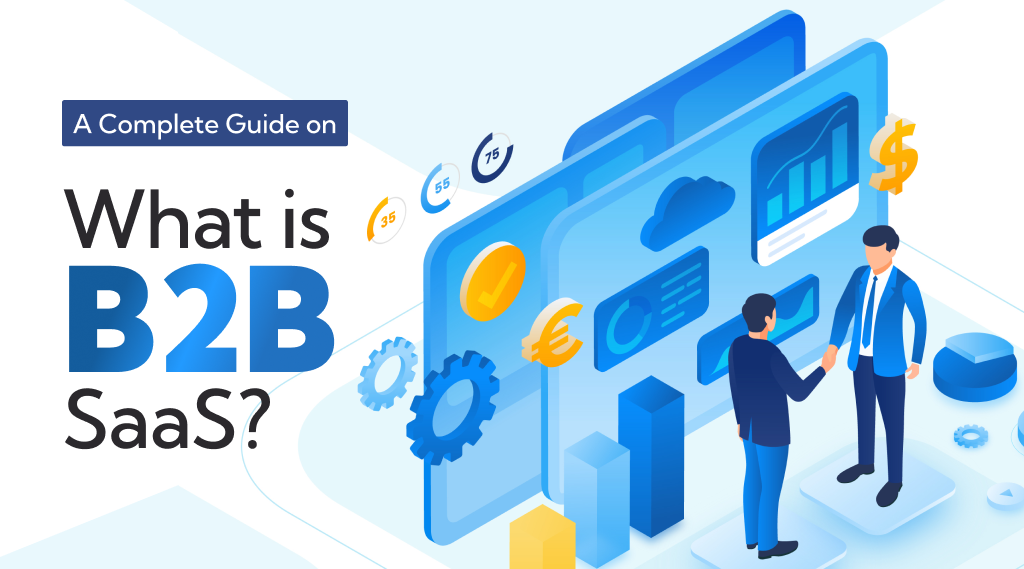Introduction:
In today’s fast-paced digital world, businesses face constant changes and new opportunities. Technology is reshaping how companies work, connect with customers, and grow. A powerful idea that can supercharge your business is at the center of this transformation: B2B SaaS.
Don’t worry if you haven’t heard of these terms before. B2B SaaS stands for “Business-to-Business Software as a Service,” but we’ll explain it in simple words. Whether you’re a business pro or just starting, understanding B2B SaaS is essential to keep up with the times and make your business shine.
This guide is here to help you understand B2B SaaS better. We’ll explain what it is, why it’s important, and how it can change the way you run your business. Whether you’re new to software or looking to make your business tech-savvy, this guide will be your friendly guidebook.
As you read on, we’ll uncover the secrets of B2B SaaS, from the basics to real-life examples. By the end, you’ll have the knowledge you need to make intelligent choices, use cool technology, and make your business thrive in a world filled with possibilities.
So, let’s start exploring the world of B2B SaaS together, where innovation meets business, and find out how this fantastic tech can help your business succeed in the digital age.
What is a B2B SaaS?
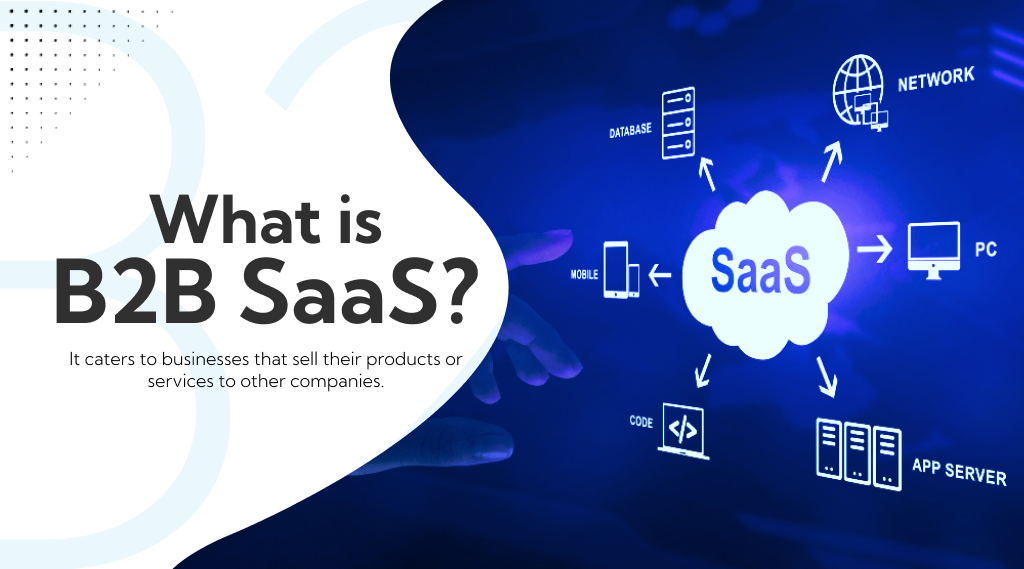
B2B SaaS, or Business-to-Business Software as a Service, refers to the delivery of software applications and solutions designed specifically to meet the needs of other businesses. These applications are hosted in the cloud and are accessed through a web browser, eliminating the need for complex installations or costly infrastructure.
Unlike traditional software, where companies purchase and install software on their servers or computers, B2B SaaS offers a more flexible and scalable approach. Businesses subscribe to these services monthly or yearly, paying for what they use, which can often be customized to their unique requirements. It combines two key concepts:
Business-to-Business (B2B): This refers to the relationship between companies that sell their products, services, or solutions to other businesses. In B2B transactions, the buyers and sellers are typically organizations, not individual consumers.
Software as a Service (SaaS): SaaS is a software distribution model in which software applications are hosted and delivered over the internet, typically on a subscription basis. Users can access these applications through web browsers, eliminating the need for local installations and maintenance.
B2B SaaS is a powerful tool enabling businesses to access, utilize, and benefit from software applications tailored to their specific needs while enjoying the advantages of cloud-based delivery and subscription-based pricing.
What is the Difference between B2B SaaS and SaaS?
In the realm of cloud-based solutions, the distinctions between B2B SaaS (Business-to-Business Software as a Service) and general SaaS (Software as a Service) are crucial for businesses navigating the digital landscape. Delving into the difference between the two reveals their nuanced approaches to target audiences and application scopes.
Business-Centric Focus of B2B SaaS:
B2B SaaS, tailored for businesses engaging with other businesses, operates as a specialized subset within the broader SaaS domain. This software architecture places emphasis on addressing the distinctive challenges inherent in B2B interactions.
Targeting Marketing Channels: Unlike general SaaS, B2B SaaS often directs its marketing channels towards businesses, recognizing the unique dynamics involved in selling products or services to other companies. This focus ensures that promotional strategies resonate effectively within the B2B space.
Customization for Existing Customers: B2B SaaS frequently offers a high degree of customization to accommodate the diverse needs of existing customers. This adaptability enhances the software’s utility in various industries, providing tailored solutions for specific B2B scenarios.
Versatility of General SaaS:
In contrast, general SaaS encompasses a broader spectrum of users, including both businesses and individual consumers. The applications under this umbrella cater to diverse needs, from personal productivity tools to entertainment services.
Applicability Across Marketing Channels: SaaS, being more encompassing, spreads across various marketing channels, serving both B2B and B2C interactions. This versatility allows businesses to leverage multiple channels such as content marketing, email marketing, LinkedIn etc to target a wide array of potential users.
Balancing Customer Acquisition Costs: Businesses utilizing SaaS often find themselves navigating the delicate balance of customer acquisition costs. This delicate equilibrium is essential for optimizing the ROI from marketing efforts across different channels.
Navigating Cloud-Based Solutions and Beyond:
Understanding the difference between B2B SaaS and SaaS is paramount for businesses seeking efficient software solutions. While B2B SaaS intricately tailors its services for streamlined B2B interactions, general SaaS extends its reach across various markets and user types. In essence, both play pivotal roles in modern software ecosystems, offering unique advantages based on the distinct needs of their target audiences.
What is a B2B Software Example?
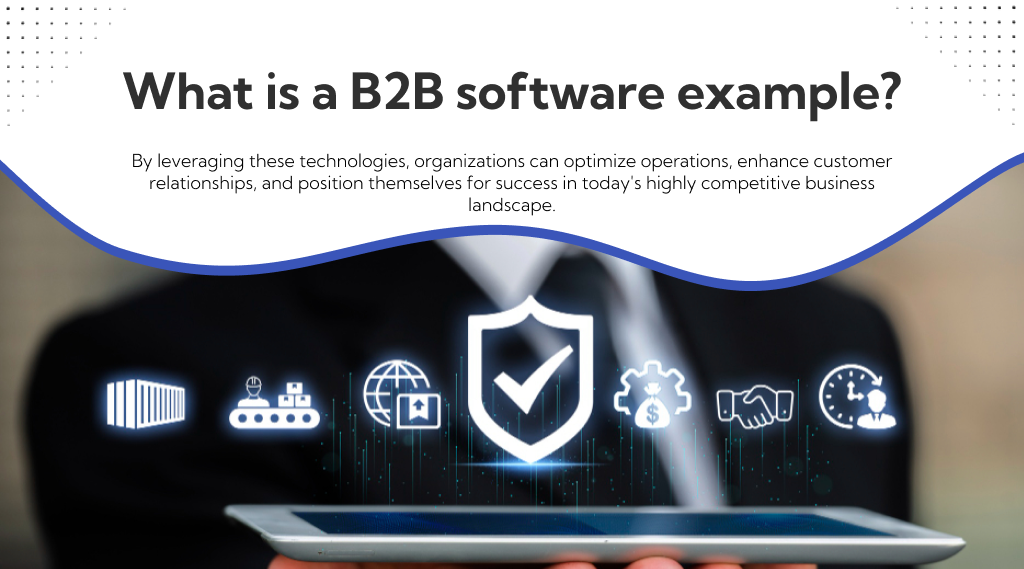
Businesses today rely heavily on specialized software solutions designed to address their unique needs. These B2B (Business-to-Business) software applications are tailored to facilitate business interactions and transactions, ultimately driving growth, streamlining processes, and fostering seamless communication. This comprehensive exploration delves into various B2B software examples, shedding light on the tools and technologies that empower organizations to thrive in the modern business ecosystem
1. Customer Relationship Management (CRM) Software:
Examples: Salesforce, HubSpot, Zoho CRM
Purpose: CRM software helps businesses manage their relationships with other businesses and clients. It centralizes customer information, tracks interactions, and streamlines sales and marketing efforts, ultimately enhancing customer engagement and satisfaction.
2. Enterprise Resource Planning (ERP) Software:
Examples: SAP, Oracle ERP, NetSuite
Purpose: ERP software integrates and manages essential business processes like finance, human resources, supply chain, and inventory management. It provides a holistic view of operations, enabling businesses to make informed decisions and improve efficiency.
3. Project Management Software:
Examples: Asana, Trello, Jira
Purpose: B2B project management tools help businesses plan, organize, and execute projects efficiently. They facilitate collaboration, task assignment, and progress tracking, ensuring projects are completed on time and within budget.
4. Accounting Software:
Examples: QuickBooks, Xero, FreshBooks
Purpose: B2B accounting software simplifies financial management by handling tasks like bookkeeping, invoicing, expense tracking, and financial reporting. It ensures accurate financial records and compliance with accounting standards.
5. Communication and Collaboration Tools:
Examples: Microsoft Teams, Slack, Google Workspace
Purpose: These platforms facilitate real-time communication and collaboration among employees within businesses and with external partners or clients. They enable file sharing, video conferencing, and project coordination.
6. Supply Chain Management Software:
Examples: Kinaxis, Oracle Supply Chain Management
Purpose: B2B supply chain management software optimizes supply chain processes, from procurement to manufacturing and distribution. It enhances visibility, efficiency, and responsiveness in the supply chain, reducing costs and improving customer satisfaction.
7. Human Resources (HR) Software:
Examples: Workday, BambooHR
Purpose: HR software streamlines HR functions such as payroll, employee onboarding, performance evaluation, and workforce planning. It automates administrative tasks, enabling HR teams to focus on strategic initiatives.
8. E-commerce Platforms:
Examples: Shopify Plus, BigCommerce Enterprise
Purpose: B2B e-commerce platforms enable businesses to create and manage online stores for selling products or services to other businesses. They provide robust catalog management, order processing, and customer relationship management features.
9. Marketing Automation Software:
Examples: Marketo, Eloqua, Pardot
Purpose: Marketing automation tools help businesses generate and nurture leads, automate email marketing campaigns, and segment customers effectively. They enhance marketing efficiency and drive customer engagement.
These B2B software examples exemplify the breadth of solutions available to businesses in various industries and functions. By leveraging these technologies, organizations can optimize operations, enhance customer relationships, and position themselves for success in today’s highly competitive business landscape.
How Does the B2B SAAS Business Model Work?
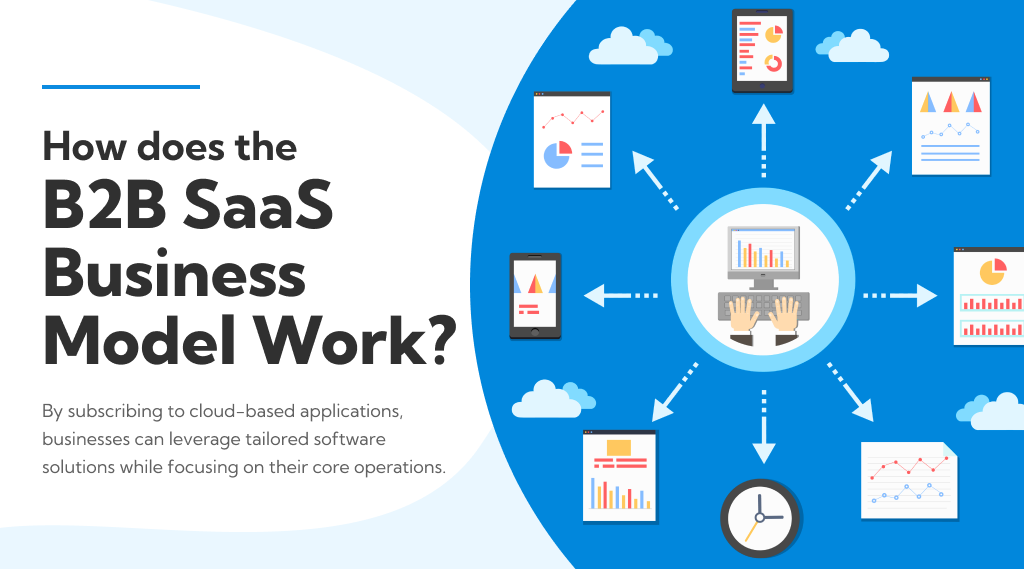
The B2B SaaS (Business-to-Business Software as a Service) business model operates on several fundamental principles, making it a highly efficient and flexible choice for businesses. Here’s a more detailed look at how it works:
1. Software Development and Hosting:
B2B SaaS companies invest in designing and developing software applications tailored to businesses’ specific needs. These applications are hosted on cloud-based servers, which means they reside on the internet rather than on a company’s local servers.
2. Subscription-Based Model:
B2B SaaS operates on a subscription-based pricing model. Businesses pay a recurring fee to access and use the software. This subscription fee can be structured in various ways, such as monthly, annually, or based on the number of users or usage levels.
3. Scalability and Customization:
B2B SaaS solutions are designed to be scalable and customizable. Businesses can easily adjust their subscription level to match their current needs, whether they need more or fewer features, additional users, or upgraded services. Additionally, these solutions often offer customization options to tailor the software to the unique requirements of different industries or business workflows.
4. Accessibility Anywhere:
One of the standout benefits of B2B SaaS is its accessibility. Users can access the software from anywhere via an internet connection and through various devices like computers, tablets, or smartphones. This flexibility enables remote work, collaboration among geographically dispersed teams, and access to critical tools on the go.
5. Ongoing Updates and Maintenance:
B2B SaaS providers are responsible for maintaining and updating the software. This means businesses do not need to worry about the technical aspects of software maintenance, such as installing patches or updates. Regular updates ensure the software remains secure, reliable, and up-to-date with the latest features and improvements.
6. Data Security:
B2B SaaS companies prioritize data security. They employ robust security measures, including data encryption, regular backups, and compliance with industry-specific regulations (e.g., GDPR for data protection). This commitment to security helps businesses protect their sensitive information.
7. Cost-Efficiency:
B2B SaaS eliminates the need for businesses to invest heavily in on-premises infrastructure and software development. By subscribing to SaaS solutions, companies can significantly reduce upfront capital expenditures. The pay-as-you-go model allows them to allocate their budgets more efficiently.
8. Customer Support:
B2B SaaS providers typically offer customer support to assist businesses in getting the most out of their software. This support may include online resources, knowledge bases, community forums, or direct access to customer service representatives who can help with technical issues or answer questions.
9. Analytics and Reporting:
Many B2B SaaS applications include robust analytics and reporting features. These tools allow businesses to gather insights from their data, track key performance indicators, and make data-driven decisions to improve their operations and strategies.
10. Subscription Management:
Businesses have control over their subscriptions through online dashboards provided by B2B SaaS providers. This self-service aspect enables businesses to add or remove users, upgrade or downgrade plans, and monitor usage, providing flexibility and transparency in managing their software subscriptions.
The B2B SaaS business model simplifies software access, maintenance, and cost-effectiveness for businesses. By subscribing to cloud-based applications, businesses can leverage tailored software solutions while focusing on their core operations, ultimately enhancing efficiency, productivity, and competitiveness in today’s dynamic business environment.
What is B2B SaaS Marketing?
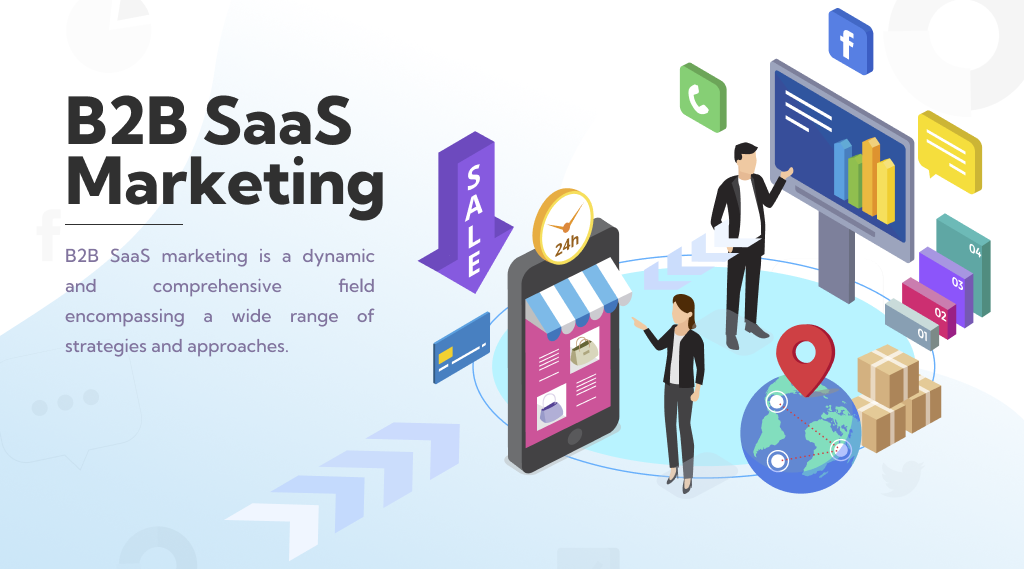
B2B SaaS marketing is a multifaceted discipline that promotes and sells Business-to-Business (B2B) Software as a Service (SaaS) solutions to other businesses. It’s a complex field that requires a unique set of strategies and approaches tailored to the B2B context. Here’s a deeper dive into the world of B2B SaaS marketing:
1. Audience-Centric Approach:
B2B SaaS marketing begins with an in-depth understanding of the target audience other businesses. This involves creating detailed buyer personas, identifying pain points, and understanding the specific challenges and goals of potential B2B customers.
2. Content Marketing:
Content is at the core of B2B SaaS marketing. Marketers produce a wide array of content, including blog posts, whitepapers, eBooks, case studies, and webinars. This content is not merely promotional but educational and informative, aimed at addressing the complex needs of B2B buyers.
3. Inbound Marketing:
B2B SaaS companies often adopt inbound marketing methodologies. This approach involves creating valuable content that attracts potential customers, optimizing websites for search engines (SEO), and using social media and other channels to draw businesses in rather than pushing marketing messages onto them.
4. Account-Based Marketing (ABM):
ABM is a highly targeted strategy where marketers focus on specific high-value accounts. This personalized approach tailors content and messaging to resonate with the unique needs of individual businesses, often involving collaboration between marketing and sales teams.
5. Email Marketing:
Email campaigns are a staple in B2B SaaS marketing. These campaigns nurture leads, share valuable content, and guide businesses through the sales funnel. Marketing automation tools are often used to personalize and streamline email communications.
6. Product Demos and Free Trials:
Offering product demos or free trials allows B2B customers to experience the software firsthand. This hands-on experience can be a persuasive tool in the decision-making process and helps showcase the software’s value.
7. Customer Success Stories:
Sharing success stories and case studies from existing customers is a powerful way to build credibility and trust. Potential customers are more likely to invest in a solution that has proven effective for businesses similar to theirs.
8. Thought Leadership:
Establishing thought leadership in the industry is crucial for B2B SaaS companies. This involves creating industry-specific content, participating in speaking engagements, and contributing to forums and discussions that position the company as an authority.
9. Data-Driven Marketing:
B2B SaaS marketers rely heavily on data and analytics. They track key performance indicators (KPIs) to measure the success of their campaigns, make data-driven decisions, and continually optimize their strategies.
10. Sales and Marketing Alignment:
Effective communication and collaboration between the sales and marketing teams are essential. Clear handoffs of leads generated by marketing efforts to the sales team are crucial for successful conversions.
11. Partnerships and Alliances:
B2B SaaS companies often form strategic partnerships or alliances with complementary businesses. These collaborations can expand their solutions’ reach and offer customers bundled offerings.
12. Customer Retention and Upselling:
B2B SaaS marketing extends beyond customer acquisition; it includes customer retention and upselling strategies. Delighted customers can become advocates and sources of referrals, further expanding the customer base.
B2B SaaS marketing is a dynamic and comprehensive field encompassing a wide range of strategies and approaches. Its ultimate goal is not just customer acquisition but also nurturing relationships, demonstrating the value of the software solution, and driving customer loyalty and advocacy within the B2B landscape.
Why Implementing Effective Marketing Strategies is Crucial for B2B SaaS Companies
Implementing and refining marketing strategies is paramount for the success of B2B SaaS (Business-to-Business Software as a Service) companies. This subtopic explores the critical role of proper marketing strategies and their impact on various aspects, incorporating key industry keywords:
1. Precision in Audience Targeting:
B2B SaaS solutions, known for their complexity, require a targeted approach in marketing. A well-orchestrated marketing strategy ensures the identification and engagement of businesses that can benefit the most from the software, thereby optimizing efforts and resources. This approach is essential for minimizing the customer acquisition cost.
2. Educational Empowerment:
Unlike consumer products, B2B SaaS products demand a deeper understanding. An effective marketing strategy involves creating educational content, aiding potential customers in grasping the value and functionality of the software. This educational aspect is crucial in B2B contexts where informed decision-making is vital. A strategic focus on keyword research ensures the content aligns with user intent.
3. Establishing Credibility and Trust:
Given the extended purchase cycles in B2B transactions, a meticulously executed marketing strategy, including thought leadership content, case studies, and customer success stories, establishes credibility and trust. Businesses are more inclined to invest in software from a reputable and trustworthy source. This trust-building process is fundamental to fostering loyal customers.
4. Gaining a Competitive Edge:
In a crowded marketplace, a well-defined marketing strategy can differentiate a B2B SaaS company from its competitors. Clear messaging, compelling content, and a solid online presence can give a company a competitive edge, making it more appealing to potential customers. Leveraging search engine optimization (SEO) and paid ads contribute significantly to this key advantage.
5. Lead Generation Expertise:
Marketing strategies are pivotal for generating leads. Effective lead generation tactics, such as content marketing, SEO, social media marketing, and email campaigns, help fill the sales pipeline with potential customers. This ensures a steady flow of opportunities for sales teams, contributing to a positive customer lifetime value.
6. Empowering Sales Teams:
Marketing strategies also play a crucial role in supporting the sales process. Marketers can provide sales teams with materials and content that assist in educating prospects, addressing objections, and closing deals. This alignment between marketing and sales is vital in B2B contexts, ensuring a smooth SaaS sales process.
7. Customer-Centric Adaptability:
A well-planned marketing strategy includes customer feedback loops. This allows B2B SaaS companies to gather insights into customer needs, pain points, and evolving requirements. These insights can inform product development and future marketing efforts, ensuring the software remains relevant and resonates with the business-to-consumer (B2C) market.
8. Measuring Performance and Optimization:
A marketing strategy should include clear KPIs (Key Performance Indicators) and measurement tools. This enables B2B SaaS companies to track the performance of their marketing efforts, identify what’s working and what’s not, and make data-driven adjustments for better results. Regular monitoring and optimization contribute to long-term success.
9. Global Outreach:
B2B SaaS companies often have the potential to serve customers worldwide. A comprehensive marketing strategy can help reach and engage businesses in various geographic regions, opening up new growth opportunities. Effective digital marketing practices ensure a global reach for the business owner seeking expanded market presence.
10. Ensuring Long-Term Success:
Building a strong brand and customer base in the B2B SaaS industry takes time and persistence. A well-thought-out marketing strategy provides the roadmap for sustained growth and long-term success, allowing companies to adapt to market changes and evolving customer needs. This approach is integral to creating a scalable marketing plan.
In conclusion, a proper marketing strategy is vital for B2B SaaS companies to effectively reach their target audience, educate potential customers, build credibility, generate leads, support sales efforts, and adapt to changing market dynamics. It’s essential for achieving sustained growth and success in the competitive world of B2B software.
Conclusion
In the dynamic realm of B2B SaaS, a well-crafted marketing strategy is not just an option; it’s a fundamental necessity. It serves as the compass that guides businesses toward their target audience, helping them educate, engage, and ultimately convert potential customers into loyal advocates. A robust marketing strategy empowers B2B SaaS companies to identify and reach the right audience, build credibility, generate consistent leads, adapt to changing customer needs, and measure and optimize performance for sustainable growth.
So, if you’re ready to elevate your B2B SaaS game, now is the time to craft a compelling marketing strategy that sets you apart from the competition and propels you toward your goals. Your future in B2B SaaS marketing begins now!
Don’t hesitate; take action today! Contact our experienced SaaS marketing experts to explore tailored strategies to propel your business to new heights. Contact us now, and let’s start this journey to success together.
FAQs
1, When did B2B SaaS start?
B2B SaaS, as a concept, began to gain traction in the early 2000s. However, its roots can be traced back to the emergence of SaaS as a delivery model in the late 1990s. Companies like Salesforce, founded in 1999, played a pioneering role in popularizing the idea of delivering software applications over the internet to businesses on a subscription basis.
2, What is B2B vertical SaaS?
B2B vertical SaaS refers to specialized SaaS solutions designed for specific industries or niches. Unlike horizontal SaaS, which caters to a broad range of industries, vertical SaaS targets the unique needs and requirements of a particular vertical or sector, such as healthcare, finance, real estate, or manufacturing. These solutions often offer industry-specific features, compliance standards, and workflows tailored to the vertical they serve.
3, Why is B2B SaaS booming in India?
B2B SaaS is experiencing significant growth in India for several reasons. The country boasts a robust talent pool of tech professionals, a growing startup ecosystem, and increasing digitization across industries. Additionally, B2B SaaS solutions often offer cost-effective alternatives for businesses looking to streamline operations, manage remote workforces, and improve efficiency, making them particularly appealing in the Indian market.
4, What are SaaS platforms?
SaaS platforms, also known as Software as a Service platforms, are cloud-based software delivery models that provide access to various software applications over the internet on a subscription basis. These platforms offer a range of services and tools that enable businesses to develop, deploy, and manage their own software solutions without the need for extensive infrastructure or in-house development. Examples of SaaS platforms include AWS (Amazon Web Services), Microsoft Azure, Google Cloud Platform, and Salesforce App Cloud.
5, How does B2B SaaS impact business scalability?
B2B SaaS can significantly impact business scalability by providing flexible, scalable solutions that grow with the needs of a business. With the ability to add or remove users, access new features, and expand services on-demand, B2B SaaS allows businesses to adapt and scale their software infrastructure quickly, efficiently, and cost-effectively to meet changing market demands and opportunities.

